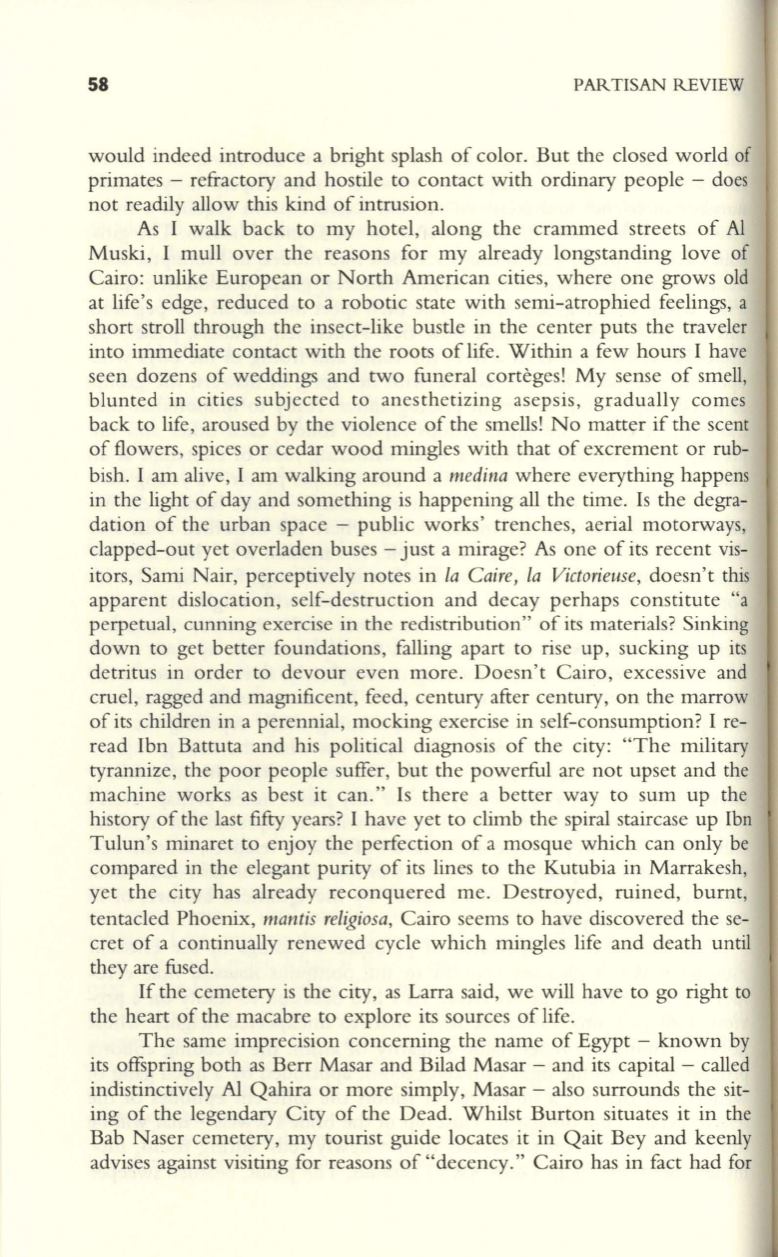
58
PARTISAN REVIEW
would indeed introduce a bright splash of color. But the closed world of
primates - refractory and hostile to contact with ordinary people - does
not readily allow this kind of intrusion.
As I walk back to my hotel, along the crammed streets of AI
Muski, I mull over the reasons for my already longstanding love of
Cairo: unlike European or North American cities, where one grows old
at life's edge, reduced to a robotic state with semi-atrophied feelings, a
short stroll through the insect-like bustle in the center puts the traveler
into immediate contact with the roots of life . Within a few hours I have
seen dozens of weddings and two funeral corteges! My sense of smell,
blunted in cities subjected to anesthetizing asepsis, gradually comes
back to life, aroused by the violence of the smells! No matter if the scent
of flowers, spices or cedar wood mingles with that of excrement or rub–
bish. I am alive, I am walking around a
medina
where everything happens
in the light of day and something is happening all the time. Is the degra–
dation of the urban space - public works' trenches, aerial motorways,
clapped-out yet overladen buses - just a mirage? As one of its recent vis–
itors, Sami Nair, perceptively notes in
La Caire, La Victorieuse,
doesn't this
apparent dislocation, self-destruction and decay perhaps constitute "a
perpetual, cunning exercise in the redistribution" of its materials? Sinking
down to get better foundations, falling apart to rise up, sucking up its
detritus in order to devour even more. Doesn't Cairo, excessive and
cruel, ragged and magnificent, feed, century after century, on the marrow
of its children in a perennial, mocking exercise in self-consumption? I re–
read Ibn Battuta and his political diagnosis of the city: "The military
tyrannize, the poor people suffer, but the powerful are not upset and the
machine works as best it can." Is there a better way to sum up the
history of the last fifty years? I have yet to climb the spiral staircase up Ibn
Tulun's minaret to
e~oy
the perfection of a mosque which can only be
compared in the elegant purity of its lines to the Kutubia in Marrakesh,
yet the city has already reconquered me . Destroyed, ruined, burnt,
tentacled Phoenix,
mantis religiosa,
Cairo seems to have discovered the se–
cret of a continually renewed cycle which mingles life and death until
they are fused .
If the cemetery is the city, as Larra said, we will have to go right to
the heart of the macabre to explore its sources of life.
The same imprecision concerning the name of Egypt - known by
its offspring both as Berr Masar and Bilad Masar - and its capital - called
indistinctively
AI
Qahira or more simply, Masar - also surrounds the sit–
ing of the legendary City of the Dead. Whilst Burton situates it in the
Bab Naser cemetery, my tourist guide locates it in Qait Bey and keenly
advises against visiting for reasons of "decency." Cairo has in fact had for


